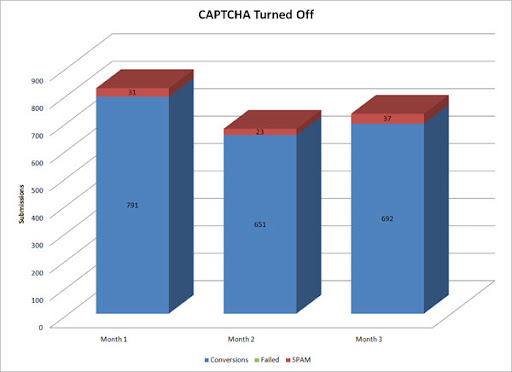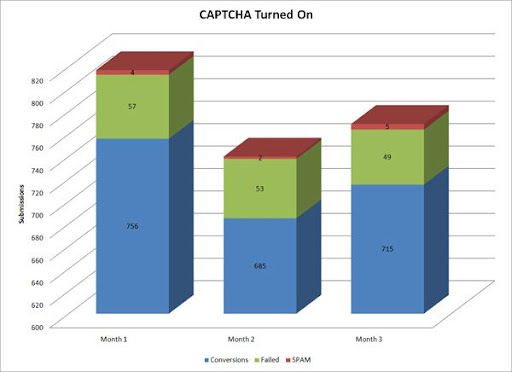CAPTCHA: The Conversion Rate Killer
By Kayla Hamahashi
March 23, 2022
Killing conversion rates since the beginning of its creation, CAPTCHA, short for Completely Automated Public Turing tests to tell Computers and Humans Apart, is more harmful than you may think. Additionally, it is no surprise that users detest solving CAPTCHAs.
While CAPTCHAs are used to block malicious bots and spam on websites, there are instances where real users are blocked as well, affecting conversion rates. Even though spam and bots may also affect conversions, CAPTCHA can be equally, if not more, disruptive to conversion rates and user experience.
What is CAPTCHA?
The sole purpose of CAPTCHA is to be able to distinguish between humans and bots while they use a website. By doing so, security is strengthened. CAPTCHA is often used for polls, registration forms, and message boards.
When CAPTCHA is implemented, users are frequently presented with a distorted word or words and are required to type the correct letters into an empty field to continue with login. One of the more commonly used types of CAPTCHA is reCAPTCHA. During reCAPTCHA tests, users are required to solve a video or audio puzzle.
Typically, bots and automated users have a difficult time solving such puzzles. As a result, they are unable to gain access to the website. By using CAPTCHA, websites are less likely to be harmed by viruses, spam, and malicious files.

What are Conversion Rates?
Conversion rates are the cornerstone of understanding the performance of your digital marketing campaigns. As an important metric in digital marketing, they measure the percentage of visitors or users on a platform that have completed a desired action.
Some examples of desired actions include member registrations, sales of products/services, page browsing, and newsletter subscriptions. The way they are calculated is simply by taking the total number of conversions and dividing it by the total number of visitors. Once this number is found, multiplying it by 100 produces your conversion rate as a percentage. The higher the conversion rate, the better the campaign performed and vice versa.
Many factors impact the achievement of high conversion rates. While these factors normally include the level of interest of the user or attractiveness of the campaign, one factor that is especially concerning is CAPTCHA.
How Does CAPTCHA Kill Conversion Rates?
Even though CAPTCHA has changed and evolved over time, one thing remains consistent – its notable impact on conversion rates. While CAPTCHA was created to weed out automated users from real ones, it is still at fault for preventing real users from entering websites due to the difficulty of its tests.
In a case study conducted on over 50 websites over 6 months, total conversions, spam conversions, and failed conversions were counted while CAPTCHA was used and not used. When CAPTCHA was turned off, 0 failed conversions occurred. However, when CAPTCHA was turned on, 159 failed conversions were reported. While these failed conversions may have been spam or bots, they could have also been real users who were unsuccessful in solving the CAPTCHA. As a result, fewer conversions were accounted for. Additionally, in a study conducted by Stanford, results revealed that CAPTCHA can reduce form conversions by up to 40%.
Overall, the implementation of CAPTCHA on websites leads to lower conversion rates. For a company, this can be detrimental. Since lower conversions can lead to a loss in sales, companies should avoid using CAPTCHA or find new ways to increase security on their websites.


What are Some Common CAPTCHA Alternatives?
If you still want your website to be protected and secure without using common CAPTCHA tests, there are many alternatives to consider.
Honeypot Solution
One alternative to common CAPTCHA is the honeypot solution. This solution presents a hidden field that is visible to bots and not humans. The idea is that bots will view this as a normal field to complete. Once filled out, the entry will be flagged as spam.
Biometric Authentication
Another method is using biometric data for human authentication. Biometric data can include fingerprint and face detection. This allows for a more seamless experience for real users and can require additional authentication when traffic is seen as suspicious.
Certain SSO’s
Another option is single sign-on (SSO) authentication. When using SSO, multiple applications can be accessed using one set of credentials. For some SSO’s in particular, such as humanID, users are authenticated through the use of their phone number rather than CAPTCHA tests. Bots are less likely to access websites which use this type of SSO due to the unique and non-duplicable nature of phone numbers.
Overall, the impact of CAPTCHA on conversion rates is important to understand. This understanding can make or break the barrier between a business and its customers. While the need for more secure websites still exists, using an alternative to common CAPTCHA is capable of differentiating between real and automated users while maintaining positive conversion rates.
Partnering with a SSO solution such as humanID not only prevents websites from malicious spam and bots, but also protects users’ personal data. Even if humanID is hacked, no personal data is leaked since it is never permanently stored. As a result, even after your login attempt is authenticated, you are still protected.


